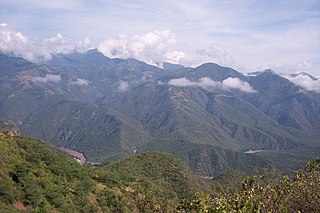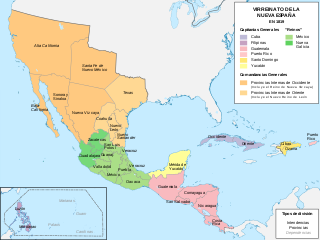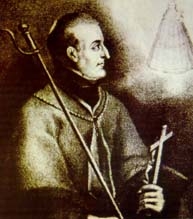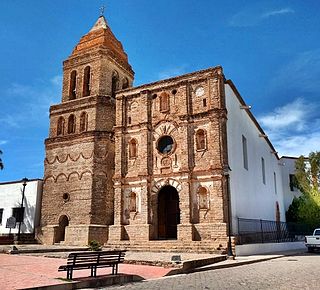
Juan Bautista de Anza Bezerra Nieto was an expeditionary leader, military officer, and politician primarily in California and New Mexico under the Spanish Empire. He is credited as one of the founding fathers of Spanish California and served as an official within New Spain as Governor of the province of New Mexico.

Sinaloa, officially the Estado Libre y Soberano de Sinaloa, is one of the 31 states which, along with Mexico City, comprise the Federal Entities of Mexico. It is divided into 18 municipalities, and its capital city is Culiacán Rosales.

The Pimería Alta was an area of the 18th century Sonora y Sinaloa Province in the Viceroyalty of New Spain, that encompassed parts of what are today southern Arizona in the United States and northern Sonora in Mexico.
A viceroyalty was an entity headed by a viceroy. It dates back to the Spanish conquest of the Americas in the sixteenth century.

Fuero, Fur, Foro or Foru is a Spanish legal term and concept. The word comes from Latin forum, an open space used as a market, tribunal and meeting place. The same Latin root is the origin of the French terms for and foire, and the Portuguese terms foro and foral; all of these words have related, but somewhat different meanings.

Cosalá is a small city and the seat of its surrounding municipality in the Mexican state of Sinaloa. It stands at 24°24′45″N106°41′30″W. The city reported 6,577 inhabitants in the 2010 census.

Nueva Vizcaya was the first province in the north of New Spain to be explored and settled by the Spanish. It consisted mostly of the area which is today the states of Chihuahua and Durango and the southwest of Coahuila in Mexico as well as parts of Texas in the United States.

The Spanish missions in the Sonoran Desert are a series of Jesuit Catholic religious outposts established by the Spanish Catholic Jesuits and other orders for religious conversions of the Pima and Tohono O'odham indigenous peoples residing in the Sonoran Desert. An added goal was giving Spain a colonial presence in their frontier territory of the Sonora y Sinaloa Province in the Viceroyalty of New Spain, and relocating by Indian Reductions settlements and encomiendas for agricultural, ranching, and mining labor.

Juan María de Salvatierra, S.J., was a Catholic missionary to the Americas.

Teodoro de Croix was a Spanish soldier and colonial official in New Spain and Peru. From April 6, 1784 to March 25, 1790 he was viceroy of Peru.

Estado de Occidente was a Mexican state established in 1824. The constitution was drafted in that year and the government was initially established with its capital at El Fuerte, Sinaloa. The first governor was Juan Miguel Riesgo. The state consisted of modern Sonora and Sinaloa, and also modern Arizona more or less south of the Gila River.

Arizpe is a small town and the municipal seat of the Arizpe Municipality in the north of the Mexican state of Sonora. It is located at 30°20'"N 110°09'"W. The area of the municipality is 2,806.78 sq.km. The population in 2005 was 2,959 of which 1,743 lived in the municipal seat as of the 2000 census.
The Real Audiencia of Mexico or Royal Audiencia of Mexico was the highest tribunal of the Spanish crown in the Kingdom of New Spain. The Audiencia was created by royal decree on December 13, 1527, and was seated in the viceregal capital of Mexico City. The First Audiencia was dissolved by the crown for its bungling and corruption and the crown established the Second Audiencia in 1530. This was supplanted by the Viceroyalty of New Spain in 1535. A new Audiencia was created in Guadalajara in western Mexico in 1548.

The Pious Fund of the Californias is a endowment, originating in 1696, to sponsor the Roman Catholic Jesuit Spanish missions in Baja California, Dominican missions in upper Baja California, and Franciscan Spanish missions in Alta California in the Viceroyalty of New Spain from 1697 to 1834, and originally administered by the Jesuits. It became the object of litigation between the US and Mexican governments in the 19th century, with the resolution making legal history in The Hague in 1902.
The Real Audiencia of Guadalajara, was the highest tribunal of the Spanish crown in what is today northern Mexico and the southwestern United States in the Viceroyalty of New Spain. It was created by royal decree on February 13, 1548, and was originally located in Compostela and permanently seated in Guadalajara in 1560. Its president was the chief political and executive officer of the district, subordinated only to the Viceroy.

The Provincias Internas, also known as the Comandancia y Capitanía General de las Provincias Internas, was an administrative district of the Spanish Empire created in 1776 to provide more autonomy for the frontier provinces of the Viceroyalty of New Spain, present-day northern Mexico and the Southwestern United States. The goal of its creation was to establish a unified government in political, military and fiscal affairs. Nevertheless, the Commandancy General experienced significant changes in its administration because of experimentation to find the best government for the frontier region as well as bureaucratic in-fighting. Its creation was part of the Bourbon Reforms and was part of an effort to invigorate economic and population growth in the region to stave off encroachment on the region by foreign powers. During its existence, the Commandancy General encompassed the provinces of New Navarre, New Biscay, The Californias, New Mexico, New Santander, New Kingdom of Leon, Coahuila and Texas.

The Consortium for North American Higher Education Collaboration (CONAHEC) is a non-profit membership organization which advises and connects higher education institutions interested in establishing or strengthening academic collaborative programs in the North American region.
Manuel Antonio Cordero y Bustamante was a Spanish soldier and politician who served as acting governor of Coahuila, governor of the same province (1798–1817), acting governor of Texas (1805–1808) and governor of the province of Sonora and Sinaloa.















